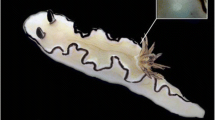Abstract
Hypselodoris nudibranchs from different geographic areas (Spain and Italy) have been studied in order to investigate their general defensive strategy. Longifolin (1) and nakafuran-9 (2) are the main ichthyodeterrent allomones used by the mollusks to avoid predation. Evidence of their dietary origin is presented and the very effective strategy against predators, which includes secretion of allomones into the mucus and their storage into specific mantle dermal formations (MDFs), is also discussed.
Similar content being viewed by others
References
Bouchet, P., andOrtea, J. 1980. Quelques Chromodorididae blues (Mollusca, Gastropoda, Nudibranchiata) de l'Atlantique Oriental.Ann. Inst. Oceanogr. Paris, 56(2): 117–125.
Cimino, G., De Rosa, S., De Stefano, S., Morrone, R., andSodano, G. 1985. The chemical defense of nudibranch molluscs.Tetrahedron 41:1093–1100.
Cimino, G., De Rosa, S., De Stefano, S., andSodano, G. 1982. The chemical defense of four Mediterranean nudibranchs.Comp. Biochem. Physiol. 73(B):471–474.
Cimino, G., De Rosa, S., De Stefano, S., andSodano, G. 1986. Marine natural products: New results from Mediterranean invertebrates.Pure Appl. Chem. 58:375–386.
Cimino, G., De Stefano, S., De Rosa, S., Sodano, G., andVillani, G. 1980. Novel metabolites from some predator-prey pairs.Bull. Soc. Chim. Bel. 89:1069–1073.
Cimino, G., De Stefano, S., Minale, L., andTrivellone, E. 1975. Furanosesquiterpenoids in sponges V. Spiniferins fromPleraplysilla spinifera.Tetrahedron Lett. 16:3727–3730.
Cimino, G., De Stefano, S., Minale, L., andTrivellone, E. 1978. Furanosesquiterpenoids in sponges VI. Further structural studies for spiniferins, sesquiterpenes fromPleraplysilla spinifera.Experientia 34:1425–1427.
Cimino, G., andSodano, G. 1989. The chemical ecology of Mediterranean Opisthobranchs.Chem. Scripta 29:389–394.
Coll, J.C., La Barre, S., Sammarco, P.W., Williams, W.T., andBakus, G.T. 1982. Chemical defences in soft corals (Coelenterata: Octocorallia) of the Great Barrier Reef: A study of comparative toxicities.Mar. Ecol. Prog. Ser. 8:271–278.
Edmunds, M., 1966. Protective mechanisms in the Eolidacea (Mollusca Nudibranchia).J. Linn. Soc. (Zool.) 46:27–71.
Faulkner, D.J. 1988a. Marine natural products.Nat. Prod. Rep. 5(6):613–663 (and previous reports in the same series).
Faulkner, D.J. 1988b. Feeding deterrents in molluscs.Mem. Calif. Acad. Sci. 13:29–36.
García-Gómez, J.C.,Covenas, R.,Medina, A., andLopez-Campos, J.L. 1986. Study of the anatomy and histology of the dermal formations (DFs) of chromodorid nudibrancs (Gastropoda: Opisthobranchia), Abstracts, 9th International Malacological Congress, Edinburgh, p. 28.
García-Gómez, J.C., Cimino, G., andMedina, A. 1990. Studies on the defensive behaviour ofHypselodoris (Gastropoda, Nudubranchia): Ultrastructure and chemical analysis of mantle dermal formations (MDFs).Mar. Biol. 106:245–250.
Guella, G., Guerriero, A., Traldi, P., andPietra, F. 1983. Penlanfuran, a new sesquiterpene from the marine spongeDysidea fragilis (Mont) of Brittany. A striking difference with the same Hawaiian species.Tetrahedron Lett. 64:3897–3898.
Guella, G., Guerriero, A., andPietra, F. 1985a. Sesquiterpenoids of the spongeDysidea fragilis of the North Brittany Sea.Helv. Chim. Acta 68:39–48.
Guella, G., Mancini, I., Guerriero, A., andPietra, F. 1985b. New furano-sesquiterpenoids from Mediterranean Sponges.Helv. Chim. Acta 68:1276–1282.
Gunthorpe, L., andCameron, A.M. 1987. Bioactive properties of extracts from Australian dorid nudibranchs.Mar. Biol. 94:39–43.
Hayashi, N., Komae, H., Eguchi, E., Nakayama, N., Hayashi, S., andSakao, T. 1972. Two new furanosesquiterpenes fromActinodaphne longifolia.Chem. Ind. 14:572–573.
Karuso, P. 1987. Chemical ecology of the nudibranchs, pp.31–60,in P.J. Scheuer (ed.). Bioorganic Marine Chemistry, Vol. 1. Springer-Verlag, New York.
Ros, J. 1976. Sistemas de defensa en los opistobranquios.Oecol. Aquat. 2:41–77.
Ros, J. 1977. La defensa en los opistobranquios.Invest. Cienc. 12:48–60.
Schulte, G.R., Scheuer, P.J., andMcConnell, O.J. 1980. Two furanosesquiterpene marine metabolites with antifeedant properties.Helv. Chim. Acta 63(8):2159–2167.
Thompson, T.E. 1960. Defensive adaptations in opistobranchs.J. Mar. Biol. Assoc. U.K. 39:123–134.
Thompson, T.E., Walker, R.P., Wratten, S.J., andFaulkner, D.J. 1982. A chemical defense mechanism for the nudibranchCadlina luteomarginata.Tetrahedron 38:1865–1873.
Author information
Authors and Affiliations
Additional information
F.P.I.-M.E.C. Spanish fellowship (University of Barcelona) at the I.C.M.I.B.
Rights and permissions
About this article
Cite this article
Avila, C., Cimino, G., Fontana, A. et al. Defensive strategy of twoHypselodoris nudibranchs from Italian and Spanish coasts. J Chem Ecol 17, 625–636 (1991). https://doi.org/10.1007/BF00982131
Received:
Accepted:
Issue Date:
DOI: https://doi.org/10.1007/BF00982131




